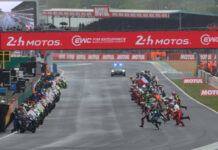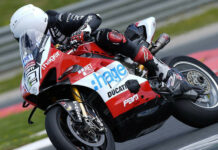Copyright 2001, Roadracing World Publishing, Inc.
By John Ulrich
The decision to not stop the second Formula USA Unlimited Superbike race at Daytona on Sunday–before the lead pack of five riders ran into what eventual winner Michael Barnes called “a wall of rain” heading into the chicane–was the worst case of officiating I can remember in the 26 years I’ve been going to races at Daytona International Speedway.
To his credit, Formula USA’s Kenny Abbott–the man who made the decision to continue–actually agreed with me and admitted that he had made a mistake when I told him that. Abbott said he didn’t want the F-USA Championship to be decided by a decision to stop the race a lap early.
Abbott was lucky that the Championship wasn’t decided by all five leaders sliding into the wall.
There was plenty of warning. Cornerworkers were reporting rain in the chicane the lap before, when Mike Ciccotto slid up the banking into the Alpina Air Fence at the exit of the chicane, somehow got bounced back onto his wheels, and took off in pursuit again.
Instead of calling for a red flag then, Abbott instructed cornerworkers to wave yellow flags and debris flags at the entrance to the chicane, explaining later that doing so eliminated passing at the point.
Waving flags and limiting passing do not produce traction. When it is wet, the Daytona chicane has scant traction under the best of circumstances, and barely any for riders on tires built for dry conditions.
Barnes described conditions in the chicane on the last lap as being “like ice”.
All five of the men in the lead pack agreed later that the race should have been stopped.
Abbott later railed about tire companies producing DOT-labelled tires that have just enough tread to avoid being labelled a “slick.” The way he sees it, DOT-labelled tires should be adequate for any conditions, wet or dry.
The flaw in that thinking is that the tire companies have enough trouble keeping DOT-labelled tires together for 12 laps now, even on machines limited to 145 horsepower. Dunlop, Metzeler and Michelin all had examples of their latest semi-slick DOT-labelled tires chunk during practice at Daytona, and two out of the three had tires chunk during the first, dry Formula USA race at Daytona. Adding tread will only make the tires more prone to chunking in dry conditions.
The real problem here is a lack of priority given to rider safety. It is a problem not unique to Formula USA. Indeed, it seems to infect race officials of every stripe.
At Virginia International Raceway in September, AMA Pro Racing’s Gary Mathers was more concerned about keeping practice on schedule than he was about placing additional Air Fence in front of a bare steel barrier Jamie Hacking had just hit. His rationalization was that Hacking’s hit was a fluke, unlikely to happen again. That same thinking after Thomas Wilson hit a bare wall at Loudon circa 1998 led to Miguel Duhamel hitting the same still-bare wall later the same day, nearly ending his career.
Long before I started the Roadracing World Air Fence Fund, AMA Trustee and American Honda Vice President Ray Blank–the man ultimately in charge of American Honda’s racing programs–told me that rider safety had to be the top priority for AMA Pro racing.
Blank was right, even if that message has obviously not permeated down to the operational level.
It is a message that Formula USA officials would do well to follow as well.
Formula USA has a Safety Director in Roger Lyle, but apparently he’s only used to place haybales and Air Fence and has no say in race operations in regards to track conditions. Lyle told me that he would have stopped the race, had he been given a chance or authority to do so.
Sandy McPherson–the veteran race control official who originally trained nearly every well-known race official now affiliated with Formula USA, including Lyle and Abbott–told me that she would have stopped the race, had she been given a chance or authority to do so.
And it’s not like Formula USA has not faced this type of problem before–the same thing happened at VIR in July, rain falling on the last lap of the second Unlimited Superbike race, with the same lame non-response.
The first priority has to be rider safety. If it starts raining enough to wet the track during a race, pull out the red flags. Then either call it a race or restart, depending upon how many laps have been run.
And no, this is not about who did or didn’t win. I don’t care about who won the race, or the Championship.
What I care about is officiating that keeps rider safety as the top priority, every race, every track, every time.
Formula USA’s Bill Syfan told me later that, had officials stopped the race at Daytona, they would have had as many or more people complaining about that decision as they did with the decision they made to continue the race.
Anyone who thinks that continuing that race was the right decision needs to be suited up and sent down the back straightaway at 160 mph, through a wall of water and into a soaking chicane, on dry-pattern DOT-labelled tires. Then we’ll talk.
Chances are, they would reach the same conclusion as the riders in the lead pack, Michael Barnes, Shawn Higbee, Mike Ciccotto, Lee Acree and Grant Lopez: The race should have been stopped.
The question now is, will Formula USA officials learn from this mistake and improve and codify the decision-making process for such situations?
Or just continue to hope they luck out in the future, and that the lead pack makes it back around to the finish line?
One can only hope…
Opinion: F-USA Finale Featured Worst Daytona Officiating In 26 Years
Opinion: F-USA Finale Featured Worst Daytona Officiating In 26 Years
© 2001, Roadracing World Publishing, Inc.






